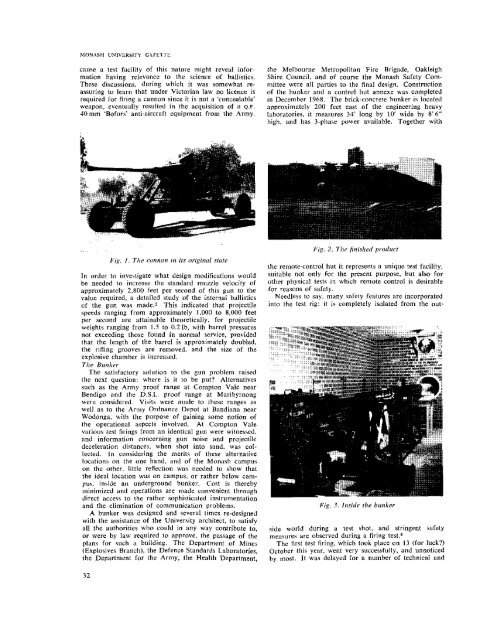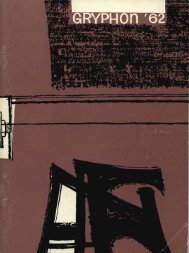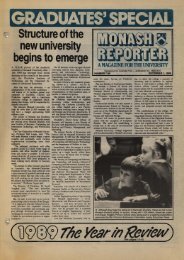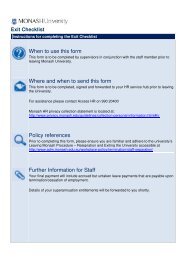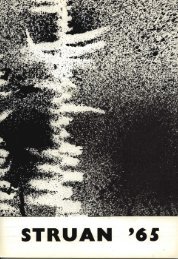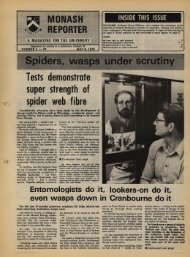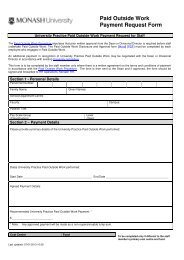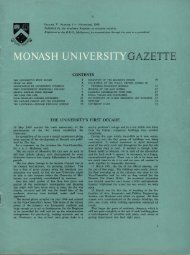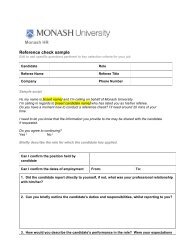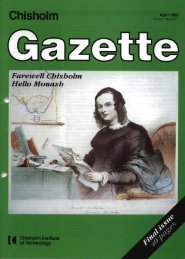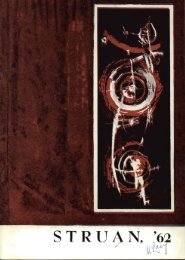MONASH UNIVERSITY GAZI.:1TEc<strong>au</strong>se a test facility of this nature might reveal informationhaving relevance to the science of ballistics.These discussions, during which it was somewhat reassuringto learn that under Victorian law no licence isrequired for firing a cannon since it is not a 'concealable'weapon, eventually resulted in the acquisition of a Q.F.40 mm 'Bofors' anti-aircraft equipment from the Army.the Melbourne Metropolitan Fire Brigade, OakleighShire Council, and of course the <strong>Monash</strong> Safety Committeewere all parties to the final design. Constructionof the bunker and a control hut annexe was completedin December ]968. The brick-concrete hunker is locatedapproximately 200 feet east of the engineering heavylaboratories, it measures 34' long by 10' wide by 8' 6"high, and has 3-phase power available. Together withFig. J. The callnon in its original stateIn order to investigate what design modifications wouldbe needed to increase the standard muzzle velocity ofapproximately 2,800 feet per second of this gun to thevalue required, a detailed study of the internal ballisticsof the gun was made.a This indicated that projectilespeeds ranging from approximately 1.000 to 8,000 feetper second are attainable theoretically. for projectileweights ranging from 1.5 to 0.21b, with barrel pressuresnot exceeding those found in normal service, providedthat the length of the barrel is approximately doubled,the rifling grooves are removed. and the size of theexplosive chamber is increased.The BunkerThe satisfactory solution to the gun problem raisedthe next questjon: where is it to be put? Alternativessuch as the Army proof range at Compton Vale nearBendigo and the D.S.L. proof range at Maribyrnongwere considered. Visits were made to these ranges aswell as to the Army Ordnance Depot at Bandiana nearWodonga, with the purpose of gaining some notion ofthe operational aspects involved. At Compton Valevarious test firings from an identical gun were witnessed.and information concerning gun noise and projectiledeceleration distances, when shot into sand. was collected.In considering the merits of these alternativelocations on the one hand, and of the <strong>Monash</strong> campuson the other. little reflection was needed to show thatthe ideal location was on campus, or rather below campus.inside an underground bunker. Cost is therebyminimized and operations are made convenient throughdirect access to the rather sophisticated instrumentationand the elimination of communication problems.A bunker was designed and several times re-designedwith the assistance of the <strong>University</strong> architect, to satisfyall the <strong>au</strong>thorities who could in any way contribute to,or were by law required to approve, the passage of theplans for such a building. The Department of Mines(Explosives Branch), the Defence Standards Laboratories,the Department for the Army, the Health Department,Fig. 2. The finished productthe remote-control hut it represents a unique test facility,suitable not only for the present purpose, but also forother physical tests in which remote control is desirablefor reasons of safety.Needless to say. many safety features are incorporatedinto the test rig: it is completely isolated from the out-Fig. 3. Inside the bunkerside world during a test shot, and stringent safetymeasures are observed during a firing test."The first test firing, which took place on 13 (for luck?)October this year. went very successfully, and unnoticedby most. It was delayed for a number of technical and32
•PRIZE SHARED BYSTAFF MEMBERA member of the <strong>Monash</strong> Medical faculty, Dr FrederickHocking, this year shared an international prize awardedto psychiatrists. This prize. which was awarded for thefirst time this year, is the Gutheil-von Domarus Prizesponsored by the American Association for the Advancementof Psycho-Therapy.Dr Hocking's entry was based on a thesis entitledHuman Reactions to Extreme Environment Stress, forwhich he was awarded a Doctorate of Medicine by<strong>Monash</strong> in 1968. Much of the thesis is devoted totracing the case histories of 312 former inmates of Naziconcentration camps.The prize was shared between Dr Hocking and ProfessorH. Garner, professor of Psychiatry at the <strong>University</strong>of Chicago.ENGINEERING TEACHING INNOVATION<strong>Monash</strong>'s Mechanical Engineering department has devisedan '<strong>au</strong>thentic involvement scheme' to improveteaching of final year design. This combats limitedcampus facilities by enabling design students to workfor one term with industrial companies. In 1969several local companies provided current design problemswhich were posed to groups of three students. Forthe six problems chosen, the companies' project engineersled seminars with the class outlining requirements.Student teams were then given responsibility for findinga solution.organizational reasons, such as the intricate machiningof the gun barrel, the manufacture of the recoil takeupstation, the test section, the decelerator, the explosivesmagazine, and of various projectiles, firing controls, etc.Last but not least the provision of the numerous safetydevices, including fences and warning notices, took itsshare of time. With all these obstacles overcome it wassatisfying to note that the gun in its isolation did notobtrude, even with noise, on its peaceful surroundingsduring firing. It should perhaps be stressed that thelength of 8 feet of the projectile track is the only partof the 26 feet of the trajectory that is not fully contained.Flight of the projectile over this partly-exposedlength of 8 feet is itself constrained by guide ways.Minor modifications are as yet required before thecomplete test system is fully operational. By that timetest shots are planned at irregular intervals. and shouldnot exceed three to four per day - hardly enough tostart a revolution!lR. C. V<strong>au</strong>ghn, Lockheed Aircraft CorporationUltra-high-speed machining. A.M.e. Technical Report6IJ·7·635 III. June 1960.2G. D. Poloxatkin, V. D. Kusnetsov and M. P. Kalashnikova- The study of cutting processes at very highspeeds. Fizika MetaLlov i Metallovedenie 10 (3), 425,1960."G, Arndt-A review of internal ballistic theory. Itsapplication to (J high-speed explosive drive. M.A.M.L.Report, No.4, Mal/ash <strong>University</strong>. Lulv 1968.4G. Arndt - Report on technical and safety aspectsof proposed ultra-high-speed cutting arrangement at<strong>Monash</strong>. <strong>University</strong>. Department of Mechanical Engineering,November 1967.MANNIX PLANS FOR225 STUDENTSThe blessing and official opening of Mannix College byHis Grace, Archbishop Knox. took place on Friday 28February 1969. This residential college, for male studentsof <strong>Monash</strong>. was the first college to be affiliatedwith the <strong>University</strong>.Situated at the main entrance of the <strong>University</strong>, inWellington Road. Mannix College will eventually accommodate225 undergraduate and graduate students.The college is named in honour of the late ArchbishopMannix.In the course of his address Archbishop Knox said:'Amongst the students forming the foundation groupthere are some twenty from Asia. This is surely anaspect that would have given much satisfaction to ArchbishopMannix.'He went on to announce that His Holiness, Pope P<strong>au</strong>lVI, had named Sir Michael Chamberlin (first DeputyChancellor of <strong>Monash</strong>) a Knight Commander of theOrder of Pius. This honour was conferred in recognitionof the contribution made by Sir Michael to theChurch and to <strong>edu</strong>cation.The Archbishop also announced that Dr Colin Clarke,presently director of the Agricultural Economics ResearchInstitute at Oxford, had accepted the position ofdirector of an institute which will carry out research onmatters relating to <strong>edu</strong>cation and population. Thisinstitute, which was instigated as a result of a recentpapal encyclical, will be located near the college.Other speakers at the opening ceremony were: TheVictorian Minister for Education, Mr L. H. S. Thompson,the Federal Minister for the Army, Mr P. R.Lynch, the Provincial of the Dominican Fathers, VeryReverend 1. J. O'Rourke, O.P; and the Chancellor of<strong>Monash</strong> <strong>University</strong>, Sir Douglas Menzies.A I.. JONES RADIOCHEMICAL LABORATORYThe radiochemical laboratory on the first floor of thechemistry building has been named the A. L. JonesRadiochemical Laboratory. after the late Dr AlbertLeonard Jones, a senior lecturer in that department from1964 to July 1968.In his letter recommending that the laboratory benamed in memory of Dr Jones. Professor Swan, thenacting-chairman of the department, wrote:'Dr Jones joined the Chemistry department in 1964and was entirely responsible for the teaching of radiochemistry,for setting up the radiochemical laboratory,and for designing and supervising the practical workdone therein by undergraduates. His personal researchinvolving several graduate students also made extensiveuse of the radiochemical facilities.'Dr Jones was a greatly admired and respected memberof the Chemistry department staff. His suddendeath in England late last year while on study leavewas a great loss to us all and I am supported by all ofmy colleagues when I request that some permanentmemorial be made to him in the Chemistry department.Tn view of his very close association with the radiochemicallaboratory we think it would be fitting if wewere allowed to name this room after him',33


